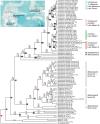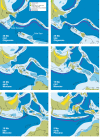Age estimates for an adaptive lake fish radiation, its mitochondrial introgression, and an unexpected sister group: Sailfin silversides of the Malili Lakes system in Sulawesi
- PMID: 24886257
- PMCID: PMC4029975
- DOI: 10.1186/1471-2148-14-94
Age estimates for an adaptive lake fish radiation, its mitochondrial introgression, and an unexpected sister group: Sailfin silversides of the Malili Lakes system in Sulawesi
Abstract
Background: The Malili Lakes system in central Sulawesi (Indonesia) is a hotspot of freshwater biodiversity in the Wallacea, characterized by endemic species flocks like the sailfin silversides (Teleostei: Atherinomorpha: Telmatherinidae) radiation. Phylogenetic reconstructions of these freshwater fishes have previously revealed two Lake Matano Telmatherina lineages (sharpfins and roundfins) forming an ancient monophyletic group, which is however masked by introgressive hybridization of sharpfins with riverine populations. The present study uses mitochondrial data, newly included taxa, and different external calibration points, to estimate the age of speciation and hybridization processes, and to test for phylogeographic relationships between Kalyptatherina from ancient islands off New Guinea, Marosatherina from SW Sulawesi, and the Malili Lakes flock.
Results: Contrary to previous expectations, Kalyptatherina is the closest relative to the Malili Lakes Telmatherinidae, and Marosatherina is the sister to this clade. Palaeogeographic reconstructions of Sulawesi suggest that the closer relationship of the Malili Lakes radiation to Kalyptatherina might be explained by a 'terrane-rafting' scenario, while proto-Marosatherina might have colonized Sulawesi by marine dispersal. The most plausible analysis conducted here implies an age of c. 1.9 My for the onset of divergence between the two major clades endemic to Lake Matano. Diversification within both lineages is apparently considerably more recent (c. 1.0 My); stream haplotypes present in the sharpfins are of even more recent origin (c. 0.4 My).
Conclusions: Sulawesi's Telmatherinidae have most likely originated in the Sahul Shelf area, have possibly reached the island by both, marine dispersal and island/terrane-rafting, and have colonized the Malili Lakes system from rivers. Estimates for the split between the epibenthic sharpfins and the predominantly pelagic to benthopelagic roundfins in Lake Matano widely coincide with geological age estimates of this rift lake. Diversification within both clades clearly predates hybridization events with stream populations. For Lake Matano, these results support a scenario of initial benthic-pelagic divergence after colonization of the lake by riverine populations, followed by rapid radiation within both clades within the last 1 My. Secondary hybridization of stream populations with the sharpfins occurred more recently, and has thus most likely not contributed to the initial divergence of this benthic species flock.
Figures




Similar articles
-
Adaptive radiation and hybridization in Wallace's Dreamponds: evidence from sailfin silversides in the Malili Lakes of Sulawesi.Proc Biol Sci. 2006 Sep 7;273(1598):2209-17. doi: 10.1098/rspb.2006.3558. Proc Biol Sci. 2006. PMID: 16901841 Free PMC article.
-
Origin and intra-island diversification of Sulawesi endemic Adrianichthyidae.Mol Phylogenet Evol. 2015 Dec;93:150-60. doi: 10.1016/j.ympev.2015.07.024. Epub 2015 Aug 6. Mol Phylogenet Evol. 2015. PMID: 26256644
-
Species divergence and repeated ancient hybridization in a Sulawesian lake system.J Evol Biol. 2021 Nov;34(11):1767-1780. doi: 10.1111/jeb.13932. Epub 2021 Sep 24. J Evol Biol. 2021. PMID: 34532915
-
The ancient lakes of Indonesia: towards integrated research on speciation.Integr Comp Biol. 2011 Oct;51(4):634-43. doi: 10.1093/icb/icr101. Epub 2011 Aug 19. Integr Comp Biol. 2011. PMID: 21856735 Review.
-
Species Radiations in the Sea: What the Flock?J Hered. 2020 Feb 5;111(1):70-83. doi: 10.1093/jhered/esz075. J Hered. 2020. PMID: 31943081 Review.
Cited by
-
Sexual dimorphism in an adaptive radiation: Does intersexual niche differentiation result in ecological character displacement?Ecol Evol. 2021 Oct 2;11(21):14615-14629. doi: 10.1002/ece3.8137. eCollection 2021 Nov. Ecol Evol. 2021. PMID: 34765129 Free PMC article.
-
Mitogenomes do not substantially improve phylogenetic resolution in a young non-model adaptive radiation of freshwater gastropods.BMC Ecol Evol. 2024 Apr 8;24(1):42. doi: 10.1186/s12862-024-02235-0. BMC Ecol Evol. 2024. PMID: 38589809 Free PMC article.
-
Rugged adaptive landscapes shape a complex, sympatric radiation.Proc Biol Sci. 2016 Jan 13;283(1822):20152342. doi: 10.1098/rspb.2015.2342. Proc Biol Sci. 2016. PMID: 26763702 Free PMC article.
-
Biological action in Read-Write genome evolution.Interface Focus. 2017 Oct 6;7(5):20160115. doi: 10.1098/rsfs.2016.0115. Epub 2017 Aug 18. Interface Focus. 2017. PMID: 28839913 Free PMC article. Review.
-
Insight into the population structure of hardhead silverside, Atherinomorus stipes (Teleostei: Atherinidae), in Belize and the Florida Keys using nd2.Ecol Evol. 2017 Oct 11;7(22):9503-9517. doi: 10.1002/ece3.3457. eCollection 2017 Nov. Ecol Evol. 2017. PMID: 29187985 Free PMC article.
References
-
- Schluter D. The Ecology of Adaptive Radiation. Oxford: Oxford University Press; 2000. pp. 1–284.
-
- Losos JB, Mahler DL. In: Evolution since Darwin: the first 150 years. Bell MA, Futuyma DJ, Eanes WF, Levinton JS, editor. Sunderland, MA: Sinauer Associates; 2010. Adaptive radiation: The interaction of ecological opportunity, adaptation, and speciation; pp. 381–420.
-
- Bess EC, Catanach TA, Johnson KP. The importance of molecular dating analyses for inferring Hawaiian biogeographical history: A case study with bark lice (Psocidae: Ptycta) J Biogeogr. 2014;1:158–167.
Publication types
MeSH terms
LinkOut - more resources
Full Text Sources
Other Literature Sources

